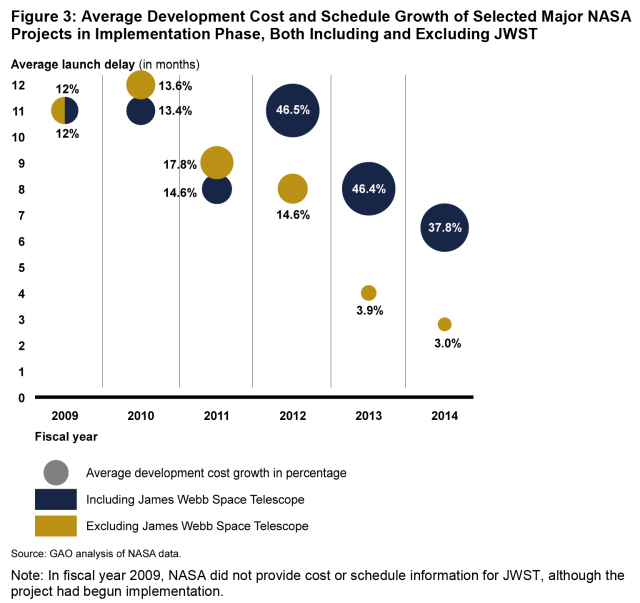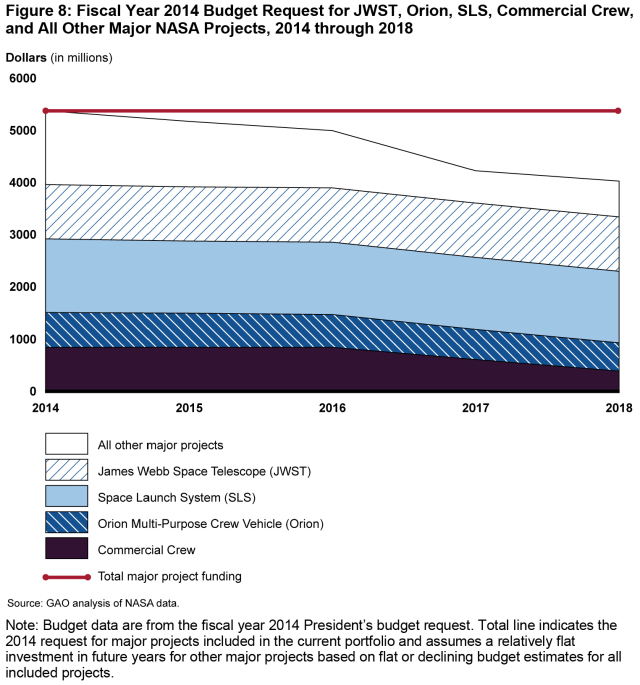GAO Reports Help NASA Oversee Major Projects

Excerpted from GAO-14-338SP
In addition to the Quick Look, we also look at specific issues at NASA. For example:- The James Webb Space Telescope (JWST): This telescope will help scientists to understand the origin of the universe and is expected to cost $8.8 billion. Recently we found that the project is performing within its commitments, but ongoing challenges could hinder its progress.
- NASA’s export control policies: As NASA develops and shares sophisticated technologies with U.S. allies, we found weaknesses that could increase the risk of unauthorized access to export-controlled technologies. Listen to our podcast on this issue:
- NASA’s ability to do more with less: Another key issue we’ve highlighted recently is NASA’s ability to complete a number of complex projects within a constrained fiscal environment. For example, in this year’s Quick Look, we reported that four projects—the Space Launch System (SLS), Orion Multi-Purpose Crew Vehicle (Orion), JWST, and Commercial Crew program—consumed 74 percent of NASA’s annual budget. Any cost or schedule overrun on these projects could have a ripple effect on the rest of NASA’s project portfolio, potentially causing project postponement or cancellation in the early development stages.

Excerpt from GAO-14-338SP
- Cost estimates: This year, we’ve found that the preliminary cost estimates for SLS, Orion, and NASA’s Ground Systems Development and Operations—which may collectively cost more than $22 billion over the next decade—are inadequate. For example, NASA intends to develop three variations of the SLS launch vehicle, but the project’s preliminary cost estimate only includes costs for one variation. In addition, many estimates for these projects do not include the long-term, life cycle costs of developing, manufacturing, and operating the launch vehicle, crew capsule, or ground systems. If NASA does not clearly define costs and schedules for initial and upcoming system capabilities, it will be difficult to determine whether programs are actually affordable, making it harder for Congress to make informed, long-term budgetary decisions.
- Questions about the content of this post? Contact Cristina Chaplain at chaplainc@gao.gov.
- Comments about the WatchBlog? Contact blog@gao.gov.

GAO's mission is to provide Congress with fact-based, nonpartisan information that can help improve federal government performance and ensure accountability for the benefit of the American people. GAO launched its WatchBlog in January, 2014, as part of its continuing effort to reach its audiences—Congress and the American people—where they are currently looking for information.
The blog format allows GAO to provide a little more context about its work than it can offer on its other social media platforms. Posts will tie GAO work to current events and the news; show how GAO’s work is affecting agencies or legislation; highlight reports, testimonies, and issue areas where GAO does work; and provide information about GAO itself, among other things.
Please send any feedback on GAO's WatchBlog to blog@gao.gov.
